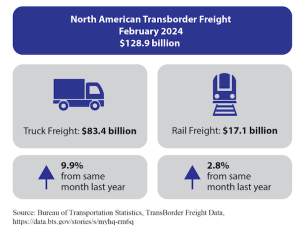Grain handlers seek stricter rail rules to avoid logjam
By: Reuters | Jun 11 2014 at 03:06 PM | Intermodal
Grain handlers are lobbying the Canadian government for even stricter rules requiring railroads to allocate thousands of railcars to them each week in hopes of stopping an unprecedented crop logjam from getting worse.
Tougher rules could ensure that U.S. and other buyers have ample access to Canadian grains. They would also give grain handlers priority over other shippers, including oil companies, which have moved a rapidly growing, though still relatively small, volume of crude by rail.
A record-large harvest and frigid weather had snarled the transportation system last fall and winter, leaving millions of tonnes of grain stuck in farm bins.
Minimum shipments to the United States, part of the grain handlers’ wish list, could keep cereal companies from suffering a repeat of last winter’s oat shortages, as Cheerios maker General Mills Inc did.
Canadian Agriculture Minister Gerry Ritz said the government intended to have new regulations in place by mid-July, possibly with tougher volume requirements.
“If it’s necessary, it will be done,” Ritz told Reuters. ” ... I’m not going to be prescriptive yet.”
Under pressure from angry farmers, Canada’s Conservative government in March ordered the nation’s two railways, Canadian National Railway Co and Canadian Pacific Railway Ltd, to boost grain shipments to minimum weekly levels.
The minimums expire in August, when the next harvest begins, but a recently passed bill allows Ottawa to set new targets for the 2014/15 crop year. Adding more regulations creates tricky politics for the Conservatives, although they have also gotten tougher on banks and phone companies.
The Western Grain Elevator Association, a handlers group whose members include Cargill Ltd, Richardson International and Viterra, is arguing for between 11,000 grain cars, the current weekly minimum, and 14,000, a level Canadian National says may overwhelm grain handlers.
WGEA is also asking for minimums along each rail corridor, such as the lines to the United States, Canada’s West Coast and Thunder Bay, Ontario.
Grain handlers, who buy crops directly from farmers to re-sell or process, say railways last winter shunned trips to the United States, which can take longer from the western farm provinces than those to Canada’s busy West Coast ports.
“If the railways ignore certain corridors and focus all movement into others, then it stands to reason that port terminals could face challenges unloading railcars,” said WGEA Executive Director Wade Sobkowich.
The grain handlers’ lobbying push extends from Ritz to federal assistant deputy ministers, whom the WGEA met with in late May, and to the government’s Canadian Transportation Agency.
The CTA is meeting individually with shippers and railways, trying to estimate how much grain must move after the next harvest. In coming weeks, it will make recommendations to Transport Minister Lisa Raitt.
Going “All Out”
Canadian National Chief Executive Officer Claude Mongeau said in an interview that the grain handlers’ call for up to 14,000 cars per week was “not constructive” since the industry had never moved more than 10,000 before the current rules.
Canadian National will deploy hundreds of U.S.-based cars in Canada for the summer to clear some of the backlog in this usually slower period and aims to temporarily deliver 6,000 grain cars per week, exceeding the current requirement for 5,500 per railway.
Port of Thunder Bay in May had its busiest month in 16 years, but there is still a mountain of grain to move.
The Canadian Agriculture Department estimates that leftover crops before the next harvest will amount to 22.4 million tonnes, the biggest pile in 34 years. Early indications point to the next crop reaching average to above-average size, adding considerably more to move.
“We’re moving all out as we speak, and we will continue into next year,” Mongeau said.
Canadian Pacific is working on an operating plan for the fall that includes improved train velocity and better use of its fleet to deliver more cars weekly, said spokesman Ed Greenberg.
Railroad consultant Tony Hatch of ABH Consulting said further Canadian railroad regulation would be “crazy,” considering the ample incentive to ship as much grain as possible.
Despite its looser regulations, the U.S. rail system works “pretty darn well,” Hatch added.
Ritz said he and Raitt would also meet with shippers and railway officials.
“The biggest difference moving forward will be the ability to get all the players around a table and talk it out,” Ritz said in an interview. “That was never done before. When it didn’t work right, they blamed each other.”
Burdensome Supplies
Considering the huge crops, a more cooperative approach looks more important than ever.
Months before farmers harvest a bushel, the Canadian arm of commodities trader Louis Dreyfus Corp [LOUDR.UL] is almost booked for spring wheat purchases through the end of 2014.
“I expect (Western Canada) will remain in a burdensome position for all of the (coming) ‘14-15 crop year and perhaps even into the following crop year,” Louis Dreyfus Commodities President Brant Randles said in an interview.
Buyers, worried about securing transportation, are making purchases three to six months in advance instead of the usual 60 days, Randles said.
Grain handlers, meanwhile, will focus their selling on the big ports on Canada’s West Coast and at Thunder Bay, said Rhyl Doyle, director of export cereals at Paterson Grain. West Coast shipments are destined for Asia, while sales through Thunder Bay can reach Europe, North Africa or Latin America.
The problem, Doyle said, is that grain handlers are so worried that they might not be able to deliver that they hesitate to sell to U.S. buyers.
“Everybody got burned on that last (winter),” Doyle said, “when the railroad said, ‘We’re not going there.’” (Reuters)







